Morris County Remembers the Centennial of U.S. Entry into World War I on April 6, 1917
Published on April 06, 2017
MANY HUNDREDS OF MORRIS COUNTY RESIDENTS SERVED IN THE WAR TO END ALL WARS'' €“ MANY GAVE THEIR LIVES
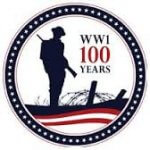 (JPG, 7KB)On April 6, 1917, 100 hundred years ago this week, the United States officially entered World War I, as President Woodrow Wilson signed a war resolution that was strongly backed by Congress.
(JPG, 7KB)On April 6, 1917, 100 hundred years ago this week, the United States officially entered World War I, as President Woodrow Wilson signed a war resolution that was strongly backed by Congress.
More than four million American families, including those in Morris County and across New Jersey, sent their sons and daughters to serve in uniform during the Great War.''
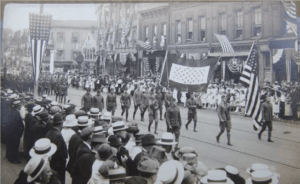 (PNG, 183KB) World War I Parade in Dover
(PNG, 183KB) World War I Parade in Dover
Some did not return. Nearly 117,000 U.S. soldiers gave their lives in combat €“ 130 of them from Morris County.
Morris County heroes like Harry Benson-Anderson of Dover, Charles Bender of Butler, Bertrand Francis Cox of Mount Freedom, Leslie Mulligan of Wharton, Giovanni Ricci of Morristown, brothers Adolph Ralph Swenson and Alwin Howard Swenson of Stirling, and nurse Amabel Scharff Roberts of Madison €“ to name a few -- were among those killed in the War to End All Wars.''
To see the full list, visit: /files/sharedassets/public/main-site/newsarchive-media/2017/World-War-I-Soldiers.pdf(PDF, 5MB)
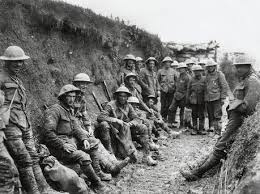 (JPG, 13KB) Soldiers rest in trench during World War I
(JPG, 13KB) Soldiers rest in trench during World War I
More than 200,000 service men and women of all ranks of life were wounded during World War I, which the United States World War I Centennial Commission terms America's forgotten war.''
The war raised patriotic passions throughout the state and county. Anti-German sentiment was so hot during World War I that Morris County officials changed the name of German Valley to Long Valley, a name that this portion of Washington Township still maintains.
During World War I, more than 350,000 African Americans served in the U.S. military, as did Native Americans and members of other minority groups. For the first time, women joined the ranks of the U.S. armed forces.
 (, 0B) Freeholder Director Doug Cabana
(, 0B) Freeholder Director Doug Cabana
We remember today the great sacrifices made 100 years ago in the name of freedom by families from across Morris County and our state and nation,'' said Morris County Freeholder Director Doug Cabana. They proudly carried this relatively new nation's banner across the sea, making great sacrifices for liberty and peace.
It is important for their families to know that we have not forgotten them, that even 100 years later we still honor their service.''
The impact on our state and county was great. For more information, visit: http://www.worldwar1centennial.org/nj-wwi-centennial-home.html or http://www.worldwar1centennial.org/index.php/nj-wwi-stories.html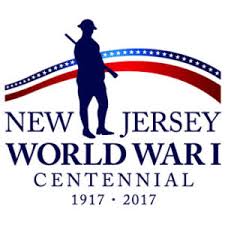 (JPG, 10KB)
(JPG, 10KB)
The list below provides a brief look at some of the brave men and women with Morris County ties who returned home from World War I as heroes.
Orrin Harry Atchison: Born in Madison in 1894. He worked as a manager at the A&P Grocery at the outbreak of WW I. He served as a Corporal and participated in the Argonne Forest Campaign. After the War, he became the Police Chief of Madison. Chief Atchison died April 20, 1957 and was buried in Hanover Cemetery.
Wallace Woodward Barker: Born in New Hampshire in 1880, he attended Harvard €“ Class of 1905. After college, he resided in Morristown, where he was a Professor of Languages at the Morristown Academy. Professor Barker enlisted on Sept. 7, 1917, as a private in Squadron A, New York Cavalry, which later became the 105th Machine Gun Battalion, 27th Division. He sailed for France in March of 1919, and transferred to the Corps of Intelligence Police, where he was stationed at Marseille and promoted to Sergeant. He died September 27, 1955 in Los Angeles, CA. where he was buried in Grand View Memorial Park, Glendale, California.
Laird Holmes Barkalow: Born in Sayreville in 1894, he grew up in Morristown and graduated from Morristown High School, class of 1913. After high school, he became a teacher at the Warford School of Music in Morristown, and was the music critic for the Morristown paper, the Daily Times. Enlisting as a Seaman in the Navy Reserves on May 7, 1917, he was assigned to Sub Chaser No. 97. After his discharge in 1921, Mr. Barkalow virtually disappeared from public view. He died January in 1939 and was buried in Washington Monumental Cemetery, South River, Middlesex County.
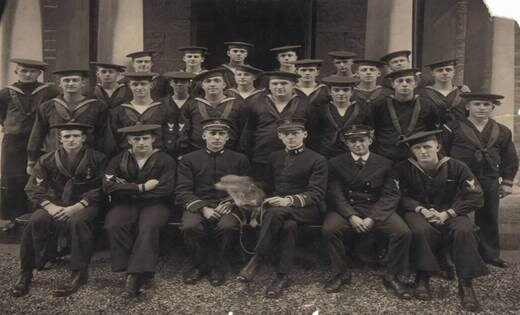 (JPG, 29KB) Crew of Sub Chaser No. 97. Seaman Laird Barkalow is last row, first on the left.
(JPG, 29KB) Crew of Sub Chaser No. 97. Seaman Laird Barkalow is last row, first on the left.
Theodore I. Berkelely: The Morristown resident served as a Second Lieutenant attached to 4th Infantry Regiment - 3d Division - A.E.F. While in an open field swept by heavy machine-gun and rifle fire, Lieutenant Berkeley was ordered by his battalion commander to seek cover in the woods; but seeing a wounded man farther to the front, he went to his aid and brought him to a place of safety. For these actions at Mont St. Pere on July 23, 1918, Second Lt. Berkeley earned the Distinguished Service Cross.
Russel A. Brown: Born in Morristown, he enlisted in the Army on July 6, 1917. Private First Class Brown was attached to the 107th Infantry Regiment - 27th Division - A.E.F., Co. He received the Distinguished Service Cross for his actions on Oct. 18, 1918 at St. Souplet, France. The following is an official account of that action: When the advance of his battalion was checked by heavy machine-gun fire, Private Brown, with two other soldiers, went forward under heavy fire to reconnoiter the enemy positions. By effective rifle fire, they drove the gunners from two machine-gun nests into a dugout nearby, which they captured, together with 35 prisoners, including three officers.''
Private First Class Brown's death date and burial location are unknown.
Eusebio Bonanni: Born in Civitella del Tronto, Italy, in 1896, he emigrated to the U.S. from Naples in 1913. He became a naturalized citizen in 1919. Mr. Bonanni settled in Boonton. He served as a Private in the United States Army during WWI in France. In civilian life, he was married for 63 years to Rosa Lauri Bonanni and they had three children: Yolanda Bonanni, Edith Bonanni Bacchetta, and Gabriel Bonanni. The couple had five grandchildren: Bernard Bacchetta, John Bonanni (who is the current Morris County Administrator), Alfred Bacchetta, Jr., Rosemarie Bonanni Sullivan and Angela Bonanni Manning. Eusebio Bonanni worked for the Jersey City Reservoir. He was an avid gardener, maintaining multiple vegetable gardens. Mr. Bonanni died July 1, 1985. He is buried in St. Mary's Cemetery, Boonton.
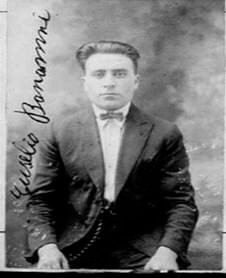 (JPG, 12KB) Eusebio Bonanni --grandfather of current Morris County Administrator John Bonanni
(JPG, 12KB) Eusebio Bonanni --grandfather of current Morris County Administrator John Bonanni
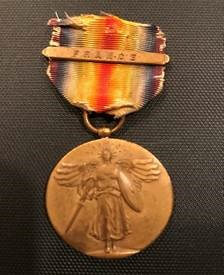 (JPG, 15KB) Eusebio Bonanni's war medal
(JPG, 15KB) Eusebio Bonanni's war medal
Cleary Brothers
Edward Aubrey Cleary: Born in Butler in 1888. He was employed at a grocery store owned by himself and his brothers, known as Cleary Brothers. His service in the war is unknown but he is listed in the pamphlet dated Sept. 20, 1919 Program of Patriotic Demonstration, Butler and Bloomingdale Veterans of the World War Homecoming. Mr. Cleary returned to Butler and later worked for Picatinny Arsenal. His death date and burial place are unknown.
Richard Joseph Cleary: Born in Butler in 1892. Mr. Cleary was a clerk for the Cleary Brothers Store. He enlisted in 1918 and served as a Private attached to the 310th Infantry, Co. M. Discharged as a Private First Class in 1919. He, like his brother Edward, was welcomed home in the Program of Patriotic Demonstration, Butler and Bloomingdale Veterans of the World War Homecoming. Mr. Cleary relocated to Las Angeles California. In 1932, he was admitted to the National Home for Disabled Veterans in Sawtelle, California, where he died December 10, 1951. He is buried in Las Angeles National Cemetery.
Robert Louis Cleary: Born in Butler in 1896. A partner in Cleary Brothers with Richard and Edward, Robert's enlistment and service in the World War are unknown, but he, too, is mentioned in the Program of Patriotic Demonstration, Butler and Bloomingdale Veterans of the World War Homecoming. Mr. Cleary's was the lone brother to survive the war. His last known living date was 1942 when he registered for WWII. His death date and burial location are unknown.
Stanley Thompson Curran: Born in New York City in 1894, he made his home in Mountain Lakes. He was a graduate of Cornell University, Class of 1917. Enlisted in 1917 into the United States Navy. Designated a Naval Aviator. The following is taken from Who's Who in American Aeronautics, published 1922: On October 11, 1918, an H-16 flying boat with the side number K-38 took the air at Naval Air Station Killingholme, England and proceeded on regularly assigned duty connected with mine laying operations in the North Sea. Near Immingham, the starboard engine cut out and the plane stalled, went into a spin and crashed into the Humber River from about 400. No reason could be assigned for the crash. Curran was the only survivor. Lt. Curran finished the war in a London Naval Hospital. Returning to Mountain Lakes, Mr. Curran worked as a telephone engineer. He died October 24, 1949; burial location is unknown.
Anna Cecelia Dunn: She was born in 1881 in Millburn. In the 1910 Federal Census, Miss Dunn was listed as working as a stenographer for a paint manufacturer. Miss. Dunn served in the United States Naval Reserve as CY (Chief Yeoman), enlisting May 29, 1918 and discharged May 28, 1920. In 1940, Miss Dunn worked as a Clerk in the Navy Department in Washington, D.C. She died January 19, 1955 and was buried in Holy Rood Cemetery in Morris Township.
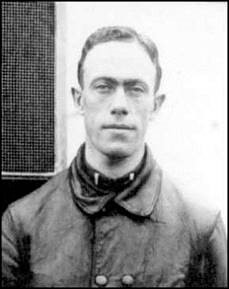 (JPG, 12KB) Major Herbert Arthur Bert Dargue
(JPG, 12KB) Major Herbert Arthur Bert Dargue
Herbert Arthur Bert Dargue: Born in Brooklyn, N.Y. in 1886. His last known residence was in Morristown. United States Military Academy, Class of 1911. On Dec. 16, 1914, he participated in the first military communication by radio while in flight. In 1916, while piloting a Curtiss JN-2 known as a Jenny, he set a flight distance record on a long-range reconnaissance mission of 415 miles with only two stops. In 1926 he aided in drafting the legislation that became the Air Corps Act, which led to the establishment of the United States Army Air Corps. During World War II, he was asked to investigate the lack of preparedness for the Pearl Harbor attack. On his way to Hawaii, Maj. General Dauge was killed when his B-18 plane crashed near the Sierra Nevada Mountains on December 12, 1941. He was buried in Arlington National Cemetery, Section 7.
John M. Grogan: Born in Brooklyn, N.Y. in 1894. Last known residence, Wharton. Mr. Grogan worked as a powder box maker at Picatinny Arsenal. Serving as a Private in World War I, he was attached to the 309 Infantry - 78th Division, Co. I. Private Grogan's friend, Private William J. Hocking -- another Wharton man €“ fought alongside him in the Battle of Ardennes. The following account was published by the Dover Advance on Sept. 26, 1921. In the same squad with Private Hocking was John M. Grogan, of Bowlbyville, who saw his friend fall from a machine gun wound as the company started over the top at Ardennes. He turned to assist his fallen comrade, but the rules of warfare brought orders from those in charge to continue in battle leaving the first aid work to the ambulance corps, which brought up the rear. Mr. Grogan, who is a member of the American Legion, was wounded the day following Private Hocking's death. Only thirteen men remained in the company of 250 after the battle, all other being killed or wounded. Mr. Grogan was one of the bearers at the funeral on Thursday when his comrade was laid to rest.
Mr. Grogan died May 10, 1942 and was buried in St. Mary's Cemetery, Dover.
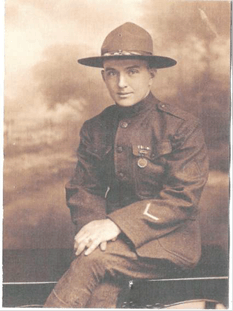 (PNG, 50KB) Corporal George Rutherford Flartey
(PNG, 50KB) Corporal George Rutherford Flartey
George Rutherford Flartey: Born in Wharton in 1891. His last known residence was Dover. Mr. Flartey was a reporter and managing editor for the Dover Advance. He, along with others, created the Dover Home Guards. They drilled, marched and carried rifles, fully loaded. In 1918, the home guard spent time at the Navy Rifle Range in Caldwell, where a number of the Guard qualified as sharpshooters. In civilian life, Mr. Flartey served as Commander of the William Hedges Baker Post in 1921. He died at age 59, and was buried August 15, 1950 in Millbrook Cemetery, Randolph.
Chaplain Frank Lewis Miller (WWI and II): Born in East Moriches, N.Y., Mr. Miller was the Chaplain at Stirling Presbyterian Church in Long Hill at the start of WWI. After his graduation from Maryville in 1914, Chaplain Miller entered Princeton Theological Seminary, graduating in 1917. In 1925, he attended the Chaplains' School at Fort Leavenworth and in 1927-1928 Columbia University, receiving his M.A. degree. He served as chaplain during the First World War; in 1920, after two years in the pastorate, became a chaplain in the Regular Army. On May 3, 1943, Colonel Miller, by then Chief of Chaplains, was a passenger aboard a B-24D. On a flight originating from the United States, the plane for reasons unknown struck a mountain approaching Reykjavik Airport in Iceland at a too low an altitude. All seven crew were killed. Chaplain Miller was buried in Arlington National Cemetery.
John D. Groff --The Grand Old Man of the Marine Corps: Born in Syracuse in 1890, Mr. Groff's residence at the start of WW I was the Kenvil section of Roxbury. Employed by the Hercules Powder Co., as a guard, he wanted more excitement in his life. He enlisted as a Private into the United States Marine Corps. As a Gunnery Sergeant in WWI, Groff was sent overseas and participating in six engagements. He was attached to the 83d Company, 6th Regiment, 2d Division - American Expeditionary Forces for actions at Belleau Woods, for which he received the Navy Cross, Silver Star, Distinguished Service Cross and Purple Heart. On 6 June 1918, while out with a patrol to obtain information essential to his commander, Gunnery Sergeant Groff was attacked by a German patrol of superior numbers. With six men he attacked the enemy, inflicted heavy losses upon them, and drove them back into the German lines.
Brigadier General Groff retired from the Marines in 1946.
Two sons followed in their father's Marine boot prints: John Louis Groff (enlisted December of 1943) and Goodwin Groff, Killed in Action, Korea.
To celebrate his 100th birthday, Brigadier General Groff reviewed the latest class of graduating Marines at Camp Pendleton. At his death, Oct 2, 1990, he was the oldest, surviving general in the Marine Corps. He was buried at Riverside National Cemetery, Riverside, California.
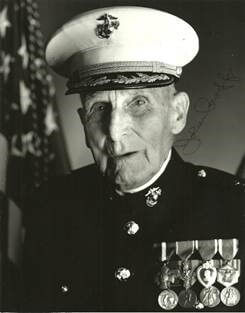 (JPG, 11KB) Brigadier General John Groff
(JPG, 11KB) Brigadier General John Groff
The Grand Old Man of the Marine Corps
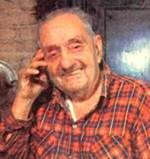 (JPG, 6KB) Lester Edward Mickens
(JPG, 6KB) Lester Edward Mickens
Lester Edward Mickens: Born in Butler in 1896, his last known residence was Kinnelon, where he was employed at the Pequannock Rubber Company. Details of his enlistment in the United States Navy are sketchy, but it is known that he was assigned to Sub Chaser service. In civilian life, Mickens was fond of calling square dances and relaying stories about his WWI service. In 1983, Mr. Mickens was the Grand Marshall of the Kinnelon Memorial Day parade. Three years later, on Sept. 18, 1986, the body of Lester Mickens, who was 89, was found by neighbors. The case was ruled a homicide, and as of 2017, this veteran's murder remains unsolved. Anyone with information may call Morris County Crime Stoppers (973) 267-2255.
Franklin Wilson Rice, M.D.: Born in New York City in 1892, Dr. Rice's last known residence was Morristown. Dr. Rice wanted a career in art, but also harbored a boyhood dream of riding in an ambulance. While studying at the New York Art Institute, he served as an intern in Bellevue Hospital, and this inspired him to enroll in Columbia Medical School, Class of 1908. At the outbreak of WW I, Dr. Rice enlisted in the Medical Corps. First Lieutenant Rice was assigned to Camp Greenleaf in Tennessee, next assigned to Evacuation Hospital no. 3. Dr. Rice returned to Morristown and resumed his medical career as a surgeon. He died August 4, 1971 and was buried in Holy Rood Cemetery.
The Terriberry Sisters
Gladys and Katharine Terriberry: Both served as Army Nurses in WWI. Gladys lived on Schooley's Mountain; she and her sister Katherine are both buried in Our Lady of the Mountain Cemetery.
Gladys Terriberry: Miss Terriberry kept a diary that was published c. 1998 Diary of Gladys Terriberry: American Army Nurse, France, 1918. A Roosevelt Hospital Nursing School graduate, Class of 1912, she was stationed in Chaumont in the Marne Valley at the Base Hospital No. 15 during World War 1.
Kathryn Terriberry: Born in 1892 in Paterson. She made her home in New York, receiving her nurse's license June, 1915 from Presbyterian Hospital in NYC. Serving as an Army Nurse, she was stationed in Base Hospital no. 2, New York. She died in 1964.
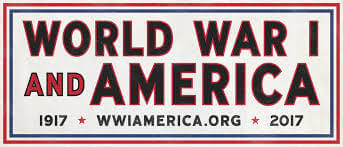 (JPG, 16KB)
(JPG, 16KB)
LEARN MORE ABOUT WORLD WAR I
Macculloch Hall Historical Museum: Women on the home front during World War I.
http://www.maccullochhall.org/exhibits/exhibits/
The Morristown and Morris Township Library: Called to Serve. World War I in Morristown and Morris Township. http://www.jfpl.org/ or https://morristourism.org/events/called-to-serve-world-war-i-exhibit-4-5-to-8-14
On Sunday, April 9, there will be an admission-free and joint event of Morris County Historical Society (Acorn Hall), Macculloch Hall Historical Museum, and the Morristown and Morris Township Library. For more information, call the library at please call the Library at 973-538-6161, MacCulloch Hall at 973-538-2404, or Acorn Hall at 973-267-3465.
Also, for more information on these and other events in Morris County and across the state, visit: http://www.worldwar1centennial.org/index.php/nj-wwi-centennial-events.html
******* Credit for this research goes to Jan Williams, who is Morris County's Cultural & Historic Resources Specialist in the Department of Planning & Public Works.